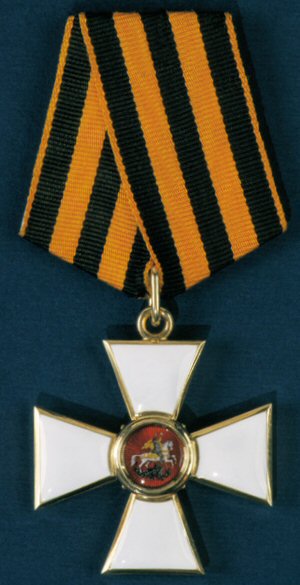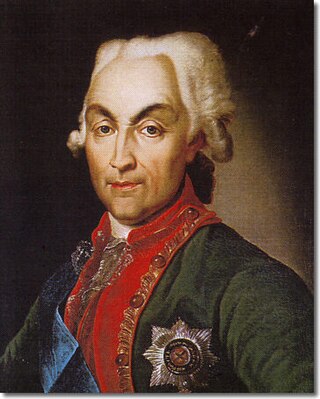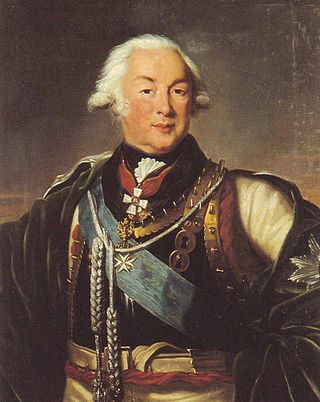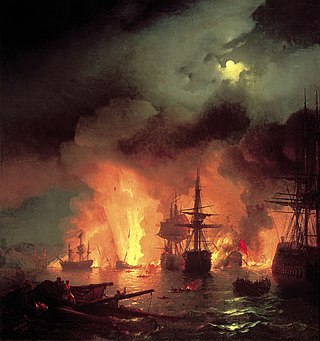
The Order of Saint George is the highest military decoration of the Russian Federation. Originally established on 26 November 1769 Julian as the highest military decoration of the Russian Empire for commissioned officers and generals by Empress Catherine the Great. After the October Revolution in 1917, it was awarded by the White movement under Alexander Kolchak until their collapse in 1921. The order was revived in the Russian Federation on 20 March 1992 by Decree №1463 of the President of Russia. The current award criteria were amended on 7 September 2010 by Presidential Decree 1099.

Tsarskoye Selo was the town containing a former residence of the Russian imperial family and visiting nobility, located 24 kilometers (15 mi) south from the center of Saint Petersburg. The residence now forms part of the town of Pushkin. Tsarskoye Selo forms one of the World Heritage Site Saint Petersburg and Related Groups of Monuments.

The Catherine Palace is a Rococo palace in Tsarskoye Selo (Pushkin), 30 km south of St. Petersburg, Russia. It was the summer residence of Russian tsars. The Palace is part of the World Heritage Site Saint Petersburg and Related Groups of Monuments.

Prince Nikolai Vasilyevich Repnin was an Imperial Russian statesman and general from the Repnin princely family who played a key role in the dissolution of the Polish–Lithuanian Commonwealth.
The Rumyantsev family (Румя́нцевы) were Russian counts prominent in Russian imperial politics in the 18th and early 19th centuries. The family claimed descent from the boyar Rumyanets who broke his oath of allegiance and surrendered Nizhny Novgorod to Vasily I of Moscow in 1391.

Antonio Rinaldi was an Italian architect, trained by Luigi Vanvitelli, who worked mainly in Russia.

Poklonnaya Gora is, at 171.5 m, one of the highest natural spots in Moscow. Its two summits were separated by the Setun River until one of the summits was razed in 1987. Since 1936, the area has been part of Moscow, and it now contains the Victory Park, with many tanks and other vehicles that were used during World War II on display.

Count Pyotr Alexandrovich Rumyantsev-Zadunaisky was one of the foremost Russian generals of the 18th century. He was also one of the most worthy commanders in universal history between 1618 and 1905. He governed Little Russia in the name of Empress Catherine the Great from the abolition of the Cossack Hetmanate in 1764 until Catherine's death 32 years later. Monuments to his victories include the Kagul Obelisk in Tsarskoye Selo (1772), the Rumyantsev Obelisk on Vasilievsky Island (1798–1801), and a galaxy of Derzhavin's odes.

The Battle of Larga was fought between 65,000 Crimean Tatars cavalry and 15,000 Ottoman infantry under Qaplan II Giray against 38,000 Russians under Field-Marshal Rumyantsev on the banks of the Larga River, a tributary of the Prut River, in Moldavia, for eight hours on 7 July 1770. It was fought on the same day as Battle of Chesma, a key naval engagement of the Russo-Turkish War, 1768–1774.

The Battle of Cahul occurred on 1 August 1770 during the Russo-Turkish War of 1768–1774. It was the decisive and most important land battle of the war and one of the largest battles of the 18th century. It was fought in Moldavia, near the village of Frumoasa, nearly a month after the Russian victory at Larga.

The Rumyantsev Obelisk is a granite obelisk located in Saint Petersburg. It is at the centre of Rumyantsev Square, on Vasilyevsky Island, between the Menshikov Palace and the Saint Petersburg Institute for Painting, Sculpture and Architecture. The obelisk commemorates the victories of Count Pyotr Rumyantsev during the Russo-Turkish War between 1768 and 1774, and his service in the Russo-Turkish War of 1787–1792.
The Catherine Park is the large landscaped area to the south of the Catherine Palace, located in the town of Tsarskoye Selo (Pushkin), 25 km south-east of St. Petersburg, Russia.
During the Seven Years' War, the Prussian-held town of Kolberg in Brandenburg-Prussian Pomerania was besieged by Russian forces three times. The first two sieges, in late 1758 and from 26 August to 18 September 1760, were unsuccessful. A final and successful siege took place from August to December 1761. In the sieges of 1760 and 1761, the Russian forces were supported by Swedish auxiliaries.

The Demidovsky Pillar is a modern obelisk on Demidov Square in the Central District of Barnaul, Russia. It is a memorial to 100 years of mining in the Altai Krai. It was begun on the initiative of Pyotr Kozmitch Frolov, with the first stone being laid on 18 June 1825 and completed in 1839.

Leningrad Hero City Obelisk is a monument in the shape of an obelisk located in Vosstaniya Square in Saint Petersburg, Russia, which was known as Leningrad from 1924 to 1991. It was installed on Victory Day of May 1985 to commemorate the fortieth anniversary of the Red Army's victory in the German-Soviet War. The monument was designed by architects Vladimir Lukyanov and A. I. Alymov.

Count Ivan Petrovich Saltykov was a Russian Field Marshal, the Governor-General of Moscow from 1797 to 1804, and owner of the grand estate of Marfino.

Kachanivka Palace is one of the many country estates built by Pyotr Rumyantsev, Catherine II's viceroy of Little Russia. It stands on the bank of the Smosh River near the village of Petrushivka in Pryluky Raion, Chernihiv Oblast, Ukraine. Perhaps the best known Rumyantsev estate in the region is the Gomel Residence.
Prince Rodion (Radukan) Matveyevich Cantacuzino was a Wallachian colonel, a participant of the Russo-Turkish War of 1768–1774. The founder of the Russian branch of the Wallachian Cantacuzino family.

Events in the year 1770 in Russia














